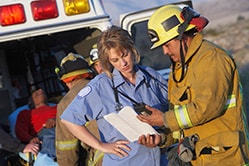Are We Prepared?

The events of September 11, 2001, and the anthrax attacks that followed, highlighted the importance of strong local, state, and federal public health systems. The 2009-2010 H1N1 influenza pandemic and the 2014-2015 Ebola outbreak further underscored the importance of preparing communities for public health threats.
Preparing for public health emergencies requires continual and coordinated efforts that involve every level of government, the private sector, non-governmental organizations, and individuals. CDC plays an important role in efforts to prepare our nation for all types of public health threats.
Each year, CDC’s Office of Public Health Preparedness and Response (PHPR) receives approximately $1.3 billion from Congress to maintain and strengthen national preparedness for public health emergencies caused by natural, accidental, or intentional events.
Congress appropriates the majority of this funding for two programs, the Public Health Emergency Preparedness cooperative agreement and the Strategic National Stockpile. PHPR allocates the remainder of the funding to preparedness programs across CDC.
Congress also provided emergency supplemental funding to address preparedness needs related to specific health threats, such as pandemic influenza or disease outbreaks.
15 public health preparedness capabilities
CDC continues to work to better define what it means to be prepared for all types of public health threats. To help public health officials better prioritize their preparedness efforts, CDC identified 15 capabilities as the basis for state and local public health preparedness.
For details, see Public Health Preparedness Capabilities: National Standards for State and Local Planning.
Measuring and reporting on state preparedness
CDC has developed and continues to design annual performance measures that are indicators of preparedness and response capabilities. These performance measures align with the objectives of the National Health Security Strategy as well as the Pandemic and All-Hazards Preparedness Act and help support program improvement through monitoring, targeted technical assistance, and training.
The 50 states, 4 localities, and 8 U.S. insular areas that receive funding from CDC’s Public Health Emergency Preparedness (PHEP) cooperative agreement submit data on annual performance measures to CDC.
CDC is committed to publicly reporting on these performance measures and progress in other PHEP-funded activities that improve the nation’s ability to prepare for and respond to public health emergencies. Preparedness reports demonstrate results, drive program improvements, and increase accountability for federal investments.
The way forward: strategies for improving state and local preparedness
Every response is local, and state and local health departments are first responders for public health emergencies. CDC remains committed to strengthening state and local preparedness and works to:
- Maintain preparedness gains and fill gaps
- Build on the successes and lessons learned emergency responses
- Ensure continuous funding to maintain a skilled state and local public health workforce
- Expand performance measurement to assess and monitor preparedness activities and to drive program improvement and accountability
For more details on each of these recommendations, refer to The 2016 National Snapshot of Public Health Preparedness.